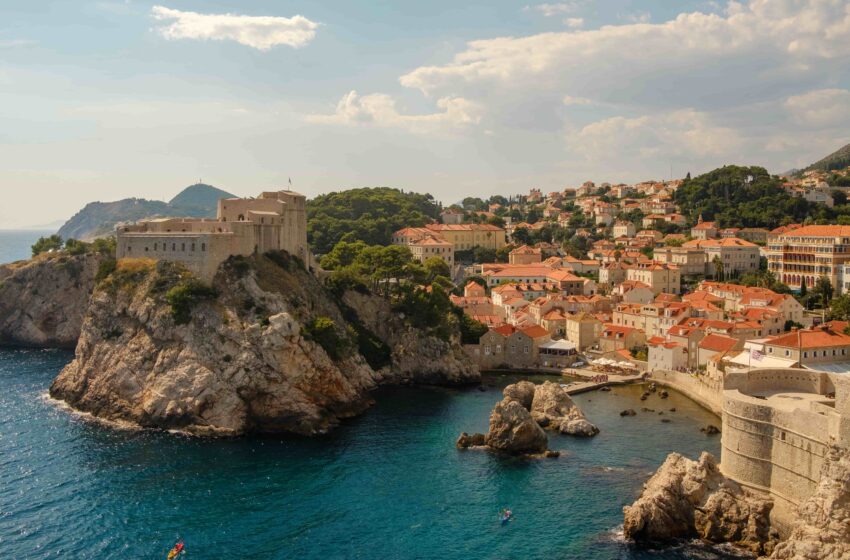
Croatia’s Only Travel Guide You Need For A Great Trip in 11 Easy Steps
- Destinations Europe
Cruisit Team
- July 26, 2022
- 0
- 4824
- 81 minutes read
Croatia’s Background
In the 7th century, the Duchy of Croatia and the nearby Principality of Lower Pannonia were merged into the Kingdom of Croatia, which existed from 925 to 1918. For over a millennia, Croatia has been passed between rival kingdoms, empires, and republics, creating a diverse history. It has been controlled by Illyrian kings, Roman and Byzantine Emperors, Venetian rulers, Hungarian Kings, Ottoman Sultans, and Habsburg Monarchs. If there is an advantage to this constant upheaval, it is in the rich cultural heritage that each has left behind. Venetian palaces coexist with Napoleonic fortifications, Roman columns sprout from early Slavic churches, and Viennese houses compete with Socialist Realist art. Excellent museums display items spanning Europe’s history, from primordial to postcommunist, creating a tale that is both intriguing and terrifying. Perched precariously between the Balkans and central Europe, the buildings, ruins, and monuments that dot the country’s stunning landscapes bear witness to its history.
Until the end of World War I, the regions that now compose Croatia were part of the Austro-Hungarian Empire. Croats, Serbs, and Slovenes founded a state in 1918 that became known as Yugoslavia in 1929. Following WWII, Yugoslavia formed a federal autonomous Communist state under Marshal Tito’s strong rule. Despite declaring independence from Yugoslavia in 1991, it took four years of occasional, but frequently harsh, conflict before occupying Serb soldiers were mainly driven out of Croatian territory. In 1998, the final Serb-held enclave in eastern Slavonia was handed to Croatia under UN supervision.
The Dalmatian coast, which stretches from Dubrovnik to Zadar is loaded with islands across its shores, which is undeniably its primary draw, with a ferry system that you cannot miss. The incredible purity of the water is the first thing that hits you. The water glows with a jewel-like brilliance in colours of emerald and sapphire when placed against a brilliant white pebbly beach. There are also large expanses of sandy and shingly beach, ideal for languid days spent relaxing and devouring trashy vacation books. If all of that seems too relaxed, there are plenty of water-based activities to tempt you away from your beach lounger, including snorkeling, diving, kayaking, windsurfing, and sailing.
Dubrovnik, even though is packed with tourists, it is definitely worth a visit. The white marble streets are dotted with baroque structures and are lined with overpriced cafés. You may pay to wander around the city on the historic wall or get lost exploring the quiet side streets. Go straight to Gradec, the old town, and take in this crowded yet relaxed city. You can wander from one park to another, see the vast Dolac market, meander the cobblestone pathways to the church, and rest at one of the numerous outdoor cafes from there.
The snow-capped coastal range that descends to approximately 6,000 kilometers of crystal pure Adriatic shoreline is a breathtaking tourist destination. With vineyards and olive groves stretching over lush valleys, old walled cities, Roman ruins, lively nightlife, and national parks, it’s no surprise that travelers discovered Croatia. Even yet, if you know where to go, you may find isolated beaches and peaceful villages.
“An island-studded shoreline on the Adriatic Sea, beautiful historic walled cities on the coasts, and a dense forest inland packed with biodiversity and waterfalls. A Mediterranean fantasy, Croatia, a country with a rich history, and a wilderness paradise for the explorer in you.“
If you take your sight away from the sparkling waters for a second, an imposing mountain will most likely appear. The Dinaric Range, which reaches from Italy to Albania, runs along much of the coast. The limestone karst has left behind a paradise of jagged peaks, caverns, river canyons, waterfalls, and impossibly beautiful lakes. As you go farther north, the landscape flattens out into rolling farmland. Active types will find plenty of opportunities to get out and about on the various hiking and bike paths, while the more daring may try their hand at rock climbing, rafting, and zip-lining.
For those who want to explore beyond the city walls and medieval buildings, take Plitvice National Park, a stunning collection of 16 lakes linked by waterfalls and wooden pathways. A popular tourist attraction, yet the various walking routes around the park provide tranquility and wonderful views.
Croatia is the type of location that has absolutely indescribable natural beauty everywhere you look. The entire nation is a perfect honeymoon destination, but also a photographer’s paradise, thanks to the brilliant colors, warm climate, and stunning seaside scenery. This might make deciding on a certain location or region challenging. You couldn’t go wrong by settling in one location, plopping down on a beach, and spending a week living out your cravings.
Along with the mentioned natural features, Croatian culture incorporates numerous European characteristics from its neighboring nations while staying distinct. Walking the elevated forts and towers of historic port cities, partying on a yacht in a new bay every day, hiking along scenic lakes and waterfalls, or simply relaxing on a quiet beach while enjoying the easily accessible food and drinks; Croatia can be the ideal destination for any type of traveler.
If you’re fortunate enough to break through the tourist barrier and be accepted into a local’s house, you’ll quickly get familiar with the phrase ‘Jedi! which means Eat! Sharing food and drinks is an important aspect of the culture in Croatia, which testifies to the essence of Croatian hospitality as well as the high quality of local cuisine. Simple, homestyle food is common at family-run pubs, but a new generation of chefs is bringing a more experimental approach to the table.
To enjoy Croatia the most, you will want to stay on the move in order to see and do as much as you can of what Croatia has to offer for tourists. In this Cruisit Croatian travel guide, we give you a plan that falls halfway in the middle, with a good mix of leisure and discovery. Enter the country from one airport and leave from another to fully experience and explore this Dalmatian dream destination. Croatia’s trip plan that we provide below is best experienced in the country’s high season in the summer, but you can also enjoy the shoulder season too. Your Mediterranean fantasies will come true, with warm days beside sapphire waters in the shade of historic walled villages.
Also, in our travel guide to Croatia, we will provide you with all the information you will need to navigate the country at ease. Croatia’s highlights, tips, transportation, top places and attractions, a handcrafted itinerary, and more will be provided for you as you read through. If you are excited enough by now, let us dig right in!
- Island-hop from Dubrovnik to Split, stopping in Brac, Hvar, Lastovo, Korcula, and Vis. It may be difficult to leave medieval towns, gorgeous bathing beaches, little villages, and friendly residents!
- Korcula, sometimes known as ‘Little Dubrovnik,’ is a fantastic alternative to Dubrovnik.
- Lastovo, a Dalmatian island easily accessible by ferry, has only been open to foreign visitors since the 1980s and is packed with hiking trails and tranquility, ideal for a tryst with nature.
- Climbers and hikers visit the national parks of Paklenica and Risnjak.
- Diocletian’s Palace is located within the city walls of Split.
- Discover the idyllic Dalmatian island of Hvar.
- Visit Plitvice Lakes National Park, which features 16 emerald-blue lakes connected by a series of thunderous waterfalls.
- Explore the Stone Age wonders of Zadar’s Romanesque Churches.
- In Zagreb, visit Gornji Grad, a historic Croatian town.
- Consider Pula’s Roman Arena on the Adriatic.
- Relax at Zlatni Rat Beach.
- Take a stroll through the picturesque town of Korcula.
- Explore the natural beauty of Mljet National Park.
- Visit Rovinj, a Venetian-era seaside village.
- Buses run frequently, are reasonably priced, and link practically every town. They are the best option for people on a budget.
- Ferries run frequent itineraries to the islands all year and are inexpensive spanning the Adriatic Sea between Italy and Greece. This is a slow-paced scenic option for those who don’t mind paying a bit extra.
- Train travel inside Croatia is rather restricted, with just a route between Split and Zagreb and overseas destinations departing from Zagreb.
- Split, Zadar, Zagreb, Dubrovnik, Rijeka, and Pula all have international airports.
- Although English is commonly spoken in most tourist locations, it is nevertheless worthwhile to learn a few important Croatian terms, necessary if you want to go away from the tourist flocks.
- Bakeries (pekarna) that provide anything from Burek (meat or cheese-filled pastry) to pizza and pastries can be a delightful and inexpensive way to satisfy your hunger.
- Carry cash because many services are only available in cash. In most cases, a tip of about 10-15% is predicted.
- Take a ferry when you’re in the Adriatic… you’ll appreciate it.
- Most beaches are rough, which can disappoint many visitors.
- Of course, get your insurance, just in case.
- If you are concerned about obtaining a visa, Croatia is a member of the Schengen region.
- By far the best time to visit Croatia is during the shoulder season when visitor activity is reduced and the cities and attractions are quieter. May-June or September-October, however, it’s worth remembering that even September may get fully booked.
- Book early because most places are completely booked throughout the summer.
- The majority of the beaches are rocky, making it difficult to find a sandy beach.
Crime & Scams in Croatia
Croatia is a highly safe country with one of the world’s lowest violent crime rates – 40 homicides per year. The country is even safer than most of its European neighbors. However, like in the rest of Europe, petty theft and pickpocketing, as well as frauds, are common.
Be vigilant, particularly if you are in cramped public places, near official buildings, crowded attractions, or on public transportation. Avoid poor areas of the city. Take care on city streets, especially after dark or if you are on your own. Don’t carry large amounts of money or wear valuable watches or jewelry. Avoid using your mobile phone in the street.
Healthcare in Croatia While Traveling
Croatia’s healthcare system is generally of high quality. Physicians can provide a good grade of treatment with the help of the Croatian government and a low cost of living. Because of the high quality of treatments available at a reduced cost, many foreigners seeking medical treatment have chosen to go to Croatia for such operations. Croatian physicians are kind, professional, and skilled at their work.
Before every trip, make sure you are up to date on all routine vaccinations. Among the key recommended vaccines globally are chickenpox (Varicella), diphtheria-tetanus-pertussis (DTP), influenza (flu), measles-mumps-rubella (MMR), polio, hepatitis, typhoid, and shingles. If you will be in contact with wildlife, you may want to consider getting a rabies vaccination.
When visiting Croatia, you are not legally required to purchase travel medical insurance. However, it is always important to have comprehensive medical coverage when traveling abroad since you never know what you may encounter while overseas.
Only eat foods that are cooked and served hot, avoid food that has been sitting on a buffet, and eat raw fruits and vegetables only if you have washed them in clean water or peeled them.
Only drink beverages from factory-sealed containers, avoid ice because it may have been made from unclean water, and only drink pasteurized milk.
Wash your hands often with soap and water for 20 seconds, especially after using the bathroom and before eating. If soap and water aren’t available, use an alcohol-based hand sanitizer that contains at least 60% alcohol. Also, keep your hands away from your face and mouth
Croatia’s climate ranges between Mediterranean near the coast and outlying islands; then there’s the continental climate inland. Summers are moderate to hot and dry near the shores, winters are mild near the shores or extremely cold in the inner lands. The climate in Croatia is diversified, but in general, no harsh climate extremes exist. What is the best season to visit Croatia? Every season in Croatia has its own attraction, but the summers are the most popular since the weather is dependable and mild, if not scorching.
Shoulder Season
Croatia’s shoulder months are May and June, or September and October; they are the transitional periods between high and low seasons and one of the best times to visit. Temperatures are still pleasant despite the unreliability of the weather. In the latter months, the sea is warm, and many, but not all, restaurants and other establishments are open. Milder weather, less people, and more inexpensive activities and lodgings are all available during the transitional seasons.
The shoulder season in Croatia is great for swimming and sunbathing. It is also less busy during these times than during the high season months of mid-June to early September. As a result, these times are the best to explore the country. In April and May, the days are already longer, giving you more time to explore while remaining cool. September and October can be ideal months for walking, hiking, cycling, and other outdoor activities.
High (Peak) Season
Mid-June through early September is the high season in Croatia and it peaks from July through mid-August. As long as you avoid the three peak weeks where crowds can be suffocating, the high season is one of the greatest seasons to visit Croatia. Peak season prices in Croatia are generally the highest, and accommodations fill up quickly. Visitors planning to visit Croatia during the summer season should book far in advance to ensure a place to stay.
Driving during peak season (July and August) may include long lines at borders and traffic congestion, particularly on weekends. Taking public transportation is considerably more predictable at this time. There are more direct international flights as well as more regular ferries in the summer months as well.
Off-Season
Croatia’s winter season is the low season which stretches from November to April. While it occasionally drops below 0°C, the temperature in Croatia throughout the winter months usually hovers around 5°C, which is rather chilly. The heartland of Croatia has a continental climate, which means that winters are bitterly cold with temperatures frequently dipping below 0°C and snow occurring on occasion. Prices in Croatia are frequently the lowest during the low season, and the nation receives the fewest tourists.
However, this time is ideal for skiing, tobogganing, sledding, Nordic skiing, and ice skating , which are among the most popular winter activities in Croatia throughout the winter months. National parks in Croatia are accessible all year, and the admission charge is generally reduced in the winter. December sees an influx of Christmas travelers who want to spend the holidays in Croatia’s festive towns and cities before welcoming the New Year. There are fewer flights available and all internal transportation links are less regular. Driving is a decent option at this time of year, however it may snow and roads can be inaccesible, especially near Lika, Gorski Kotar, and Plitvice Lakes.
By Plane
Flying is the quickest, simplest, and most inexpensive method to go to Croatia. Croatia has five major international airports that serve as entrance points into the country and they are Zagreb, Pula, Zadar, Split, and Dubrovnik. These airports handle the majority of scheduled and charter flights from Europe and North America. When compared to other modes of transportation to Croatia, tickets are frequently affordable. If you’re traveling from the United States, you’ll very likely be stopping in another European country, such as the United Kingdom, Germany, or Italy.
By Car
The great majority of visitors to Croatia arrive by vehicle. When you consider that millions of visitors come from one of Croatia’s neighboring or close nations, this isn’t as unexpected as it seems! Every year, millions of travelers travel by vehicle from Italy, Germany, Austria, Hungary, and the Czech and Slovak Republics to Croatia.
However, you have the burden of driving and navigating yourself, which some travelers may find exhausting. The extra price and distraction from the beautiful sights are offset by the flexible schedule and road trip atmosphere. The primary road entrance point from Italy in Trieste, which is reached after a short drive through Slovenia.
By Train
Many European cities, including Ljubljana, Budapest, Belgrade, Sarajevo, Graz, Vienna, Salzburg, Innsbruck, Venice, Munich, Frankfurt, Stuttgart, and Zurich, have train connections to Croatia. The primary rail destinations in Croatia are Zagreb, Pula, Rijeka, and Split; although, in the latter case, you will almost certainly have to go via Zagreb. The average travel time from various European cities to Croatian cities is around 6 hours. The shortest is about 2 hours from Ljubljana and the longest is about 15 hours from Budapest.
By Bus
If you want to go to Croatia by bus, there are coach services from all adjacent European countries, including Slovenia, Italy, Austria, Germany, the Czech Republic, and Switzerland. Whatever nation you’re coming from, you’ll almost likely be able to get to Zagreb by bus. The Zagreb Bus Terminal provides a webpage where you may check arrival schedules. There are, however, direct international bus routes to communities along the coast (towns in Istria, plus Rijeka, Zadar, Split, and Dubrovnik). There are at least ten bus companies that go from various regions of Europe to Croatian cities, however, journey time varies depending on where you depart.
The Flixbus connects northern Italy’s Venezia and Trieste with Istria and Rijeka in western Croatia. Buses that run all year are handy and pleasant. Local buses run from Trieste, the region’s main commercial center, to Pazin, Buzet, Rovinj, and Pula in Istria, as well as some handy local shuttle services. There are also a few daily bus services to and from Zagreb, Croatia’s capital.
By Boat
You can take a ferry from Italy to Croatia across the Adriatic Sea. Ferry operators serve coastal cities such as Pula, Porec, Rovinj, Zadar, Split, and Dubrovnik, but many of them are seasonal. Traveling by boat to Croatia is simple, as long as you leave Italy. Only from there are international ferry connections to Croatia available; no services operate from or to any other European country anymore. Seasonal international ferry services from Italy to Croatia run from Ancona to Zadar and Split, and from Bari to Dubrovnik.
You can use a charter or have your personal yacht and go to Croatia. Boats longer than 24 meters are permitted to enter Croatian ports. Yachts may access docks at ports of maritime tourism and ports open to public traffic, subject to current entrance requirements. Yachts may also enter shipyards for overhaul or repair. Nautical tourism is particularly popular in Croatia, and any additional measures will assist to guarantee that nautical tourists return, but with a clear overall focus on health and safety. Boat owners can enter the nation in general provided they produce proper proof of ownership (IBS, sea letter, etc., editor’s note) and submit a mooring contract, as well as alert the authorities of their impending arrival.
Traveling inside Croatia is overall straightforward and simple with multiple public transportation options, car rentals, and taxis condensed in the major cities. Internal flights, on the other hand, are useful for traversing the distances between the cities quickly, however, sometimes it is not as quick as one thinks.
By Plane
Croatia has a very broad domestic flight schedule, especially during the summer. Croatia Airlines is the country’s flag carrier, with its primary hub in Zagreb. Domestic flights arrive at Dubrovnik, Pula, Rijeka, Split, and Zadar. Trade Air flies from Osijek to Zagreb, Pula, and Rijeka, as well as from Rijeka to Split and Dubrovnik and Split to Pula and Dubrovnik.
By Train
Croatia has a small railroad network, with services that are less frequent and significantly slower than buses. Delays on Croatian trains are also common, sometimes lasting several hours. There are no railways along the coast, and only a few coastal cities are linked to Zagreb. The primary lines of importance for travelers are Zagreb-Osijek, Zagreb to Varadin, Zagreb to Rijeka to Pula, and Zagreb to Knin to Split (change in Knin for Zadar or ibenik).
By Car
Motorways connect Zagreb to Slavonia and Rijeka to Istria. Another significant highway connects Zagreb to Dalmatia, with exits for Zadar, ibenik, and Split; it continues to Dubrovnik but falls short by 68 miles (110km). Despite the fact that the roads are in great condition, there are some portions where service stations and services are rare.
Car rental is offered in all major cities, airports, and tourist destinations. Independent local enterprises are frequently significantly less expensive than worldwide chains, however the large corporations provide one-way rentals. Arranging the car from overseas or booking a fly-drive package may result in a reduced pricing. To hire a car, you must be at least 18 years old, have a valid driver’s license, and have a major credit card to cover the insurance excess.
Tolls are required on all highways, the Uka tunnel between Rijeka and Istria, the bridge to Krk Island, and the route from Rijeka to Delnice. When you join a highway, the first set of booths you see distribute tickets; you must have this at the booths when you exit the motorway, where it is used to determine the appropriate toll.
By Taxi
Taxis are widely available in Croatia, and you should have no trouble getting one in the larger cities. Prices are (in principle) shown on the meter, although it is generally a good idea to agree on a price before entering.
Prices in major cities are typically reasonable, however this might vary in outlying places. A cab from the ferry terminal at Stari Grad to Hvar Town, for example, will cost you 300 kuna or more (about 40 euro). The further you are from civilization, the less likely there will be a meter. As a result, it is even more important to agree on a charge in advance.
Taxi drivers in Croatia, as elsewhere in the globe, do not have the best reputation. Taxi scam tales may be found all throughout the world, but the issue at Zagreb Airport deserves special attention. Only licensed taxi drivers, like in much of the rest of the globe, are permitted to wait at the airport. As a result, they have a monopoly on transport into town and frequently defraud visitors. Before you go, agree on a price and keep in mind that it takes 20 minutes to get to town and is generally the most costly choice out of the airport. However, instead of the bother, you may always use Uber and obtain significantly reduced charges.
By Bus
Bus services in Croatia are outstanding and reasonably priced. Because one route is sometimes handled by many providers, pricing might vary greatly. Luggage stored in the bus’s luggage compartment is charged extra (around 10KN a piece). Have in mind that buses between Split and Dubrovnik cross through Bosnian territory, so keep your passport accessible.
Tickets must be purchased at the office, not from drivers, at big stops, and it’s recommended to reserve early to ensure a seat, especially during the summer. Arriva, FlixBus, and Azmatrans are among the major bus companies. Getbybus is a helpful service that provides schedules and bookings.
By Boat
Year-round, many boats link the main coastal communities and their adjacent islands, with services expanded during the tourist season. Split is the principal center, with Dubrovnik, ibenik, Zadar, and Rijeka as other significant ports. Locals use the term “ferry” exclusively to refer to automobile ferries, whereas “catamaran” refers to speedier, passenger-only ferry services. The primary operator is Jadrolinija, which operates car ferries and catamarans on 35 different routes.
Boats are well-equipped and pleasant, with restrooms and seating both inside and outside on the deck. The larger ships have restaurants, cafés, and bars, and virtually all feature a snack bar. Most provide free Wi-Fi. Most tickets may be purchased online, while it is not always feasible to purchase tickets on the day of travel. Because pre-booking does not guarantee you a seat on a certain sailing, it is still advantageous to arrive at the dock early during peak season, especially if you are traveling with a car. Traveling as a foot passenger allows you more freedom and is far less expensive than traveling by automobile. If you require a vehicle, scooter, or bicycle, you can usually rent one at your location.
It’s also feasible to rent a boat (with or without a crew) or get your personal yacht and cruise about on your own. Local boat rental firms may be found in all of the major coastal towns.
SIM Cards & Calls in Croatia
Hrvatski Telekom (Simpa), A1 (previously vip), Telemach (formerly Tele2), Bonbon & Tomato shops and resellers, such as convenience stores and supermarket stores, sell Croatian SIM cards for 20 HKR (2.80 USD). SIM cards are also available at the international airports of Zagreb, Dubrovnik, and Split. Tourist plans are affordable, with up to 2 GB of data and minutes valid for 7 days for as little as 24 HRK, which is plenty for a trip to Croatia.
Alternatively, you may also get a prepaid eSim card from a company like Airalo, SIMCorner, HolaFly, or Nomad. All the providers offer data-only plans that may be used with an eSim-enabled phone, so make sure your phone is compatible. It is also possible to sign up for a Solis WiFi Hotspot. Check before you travel because they only serve select areas. Airalo provides the most extensive coverage of over 180 nations.
Local Internet & WiFi in Croatia
Internet and Wi-Fi are generally available in Croatia, with excellent coverage in most metropolitan areas. However, most connections are sluggish due to the aging and poorly branched infrastructure. The average mobile internet speed is roughly 65 Mbps, while the average router internet speed is 46 Mbps, which is rather good. Wifi is quite common; you’ll almost always find it in hotels, hostels, or any other type of lodging. There is also free wifi in cafés, pubs, and hotspots around town, particularly in tourist areas.
Top Places in Croatia

Plitvice Lakes National Park
Plitvice Lakes National Park is one of Croatia’s oldest and largest national parks and was added to the UNESCO World Heritage list in 1979 for its succession of tufa lakes, caverns, and waterfalls. The protected area covers an area of 296.85 square kilometers. The national park was established in 1949 and is located in central Croatia’s hilly karst region, near the border with Bosnia and Herzegovina. In the summer admission costs up to 250 kuna (about €34) per adult per day.
Krka National Park
Krka National Park is one of Croatia’s popular national parks, named after the Krka River that it surrounds. It is located in central Dalmatia, along the middle-lower course of the Krka River, in ibenik-Knin county, downstream Miljevci region, and just a few kilometers northeast of the city of ibenik. It was established to safeguard the Krka River and is primarily intended for scientific, cultural, educational, recreational, and tourist purposes. It was designated as a national park in 1985, making it Croatia’s sixth.

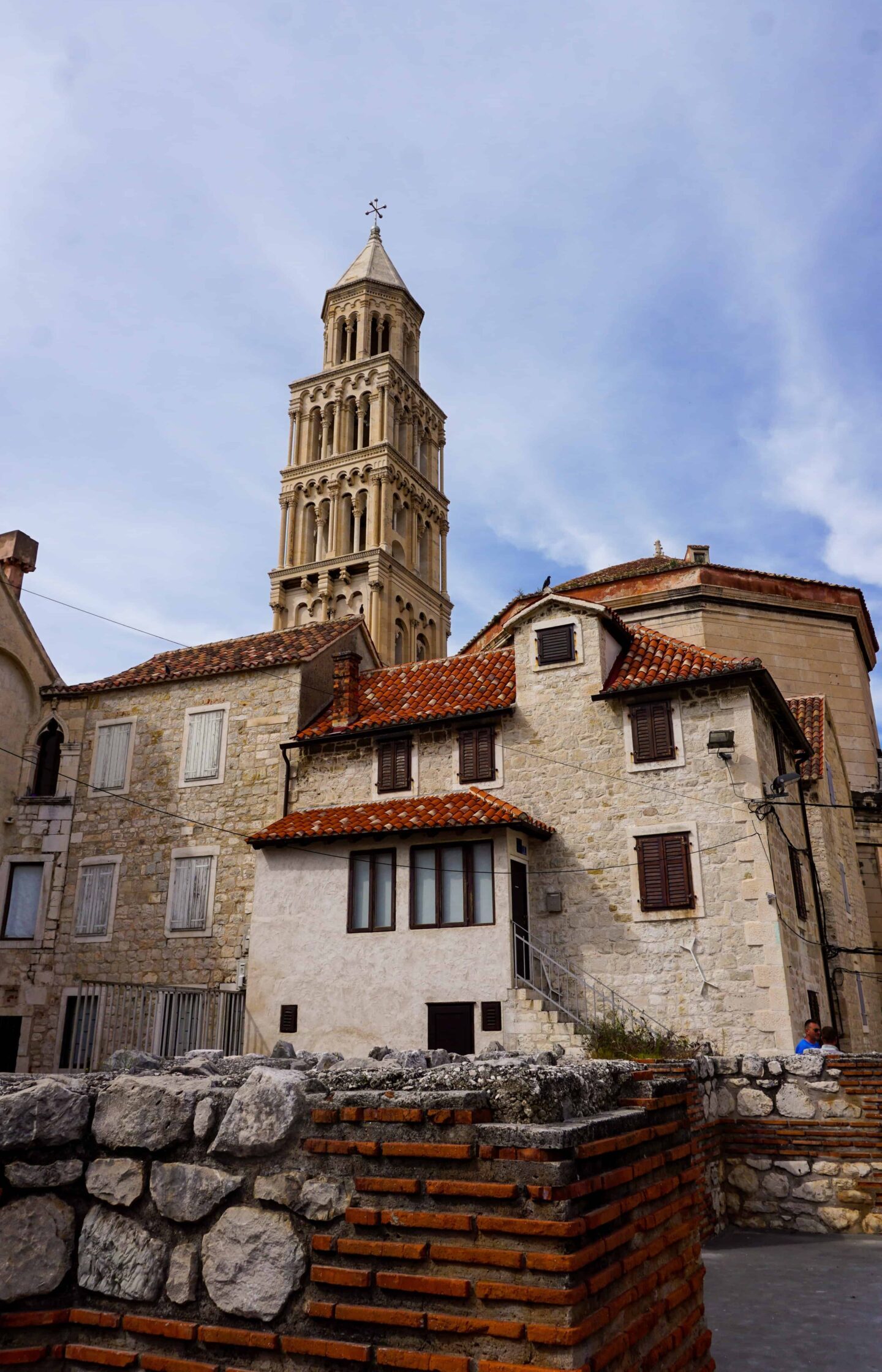
Diocletian’s Palace
Diocletian’s Palace is a huge palace erected for the Roman Emperor Diocletius at the turn of the fourth century AD, which now occupies over half of Split’s old town. The complex was constructed on a peninsula six kilometers southwest of Salona, one of the greatest towns of the late empire with 60,000 inhabitants. Salona’s topography descends gently seaward and is typical karst, with low limestone hills running east to west and marl in the clefts between them. The palace’s ruins are now part of Split’s historic centre, which was designated a UNESCO World Heritage Site in 1979.
Dubrovnik Walls
The Dubrovnik Walls are a set of defensive stone walls that surround the city of Dubrovnik in southern Croatia. They have been recognized to be among the major fortification systems of the Middle Ages, with multiple expansions and alterations throughout their existence, as they were never broken by a hostile force throughout this time period. The ancient city of Dubrovnik, which contains a significant section of the medieval walls of Dubrovnik, was added to the UNESCO list of World Heritage Sites in 1979. Dubrovnik itself is jam-packed with things to see and do, so don’t pass it up.


Zagreb Cathedral
The Zagreb Cathedral, located atop the Kaptol, is a Roman Catholic cathedral-church that is not only Croatia’s second highest structure, but also the most colossal sacral construction in Gothic style southeast of the Alps. It honors the Assumption of Mary as well as the monarchs’ Saint Stephen and Saint Ladislaus. The cathedral is typical Gothic, as is the sacristy, which has significant architectural merit. Its towering spires are regarded landmarks since they can be seen from most sections of the city. One of its two spires was damaged by an earthquake in 2020.
7-day Itinerary in Croatia
Day 1
Arrive in Dubrovnik
Dubrovnik is the pearl of the Adriatic Sea, and it is the ideal site to begin your Croatian trip. After checking into your hotel and dropping your bags, make your way to the Old Town to explore the maze of alleyways and limestone streets and take in the sights and sounds of this old city.
Take a stroll along the mile-long white stone walls that enclose the ancient old town for famous views of the orange-roofed settlement (King’s Landing) and distant islands that dot the horizon. Make your way to Restaurant 360 Dubrovnik for a Michelin-starred meal on a warm rooftop, an ideal setting for your first evening in the city. You may also chose from a broad range of restaurants that serve some of the best pizza or maybe you fancy some fresh fish?
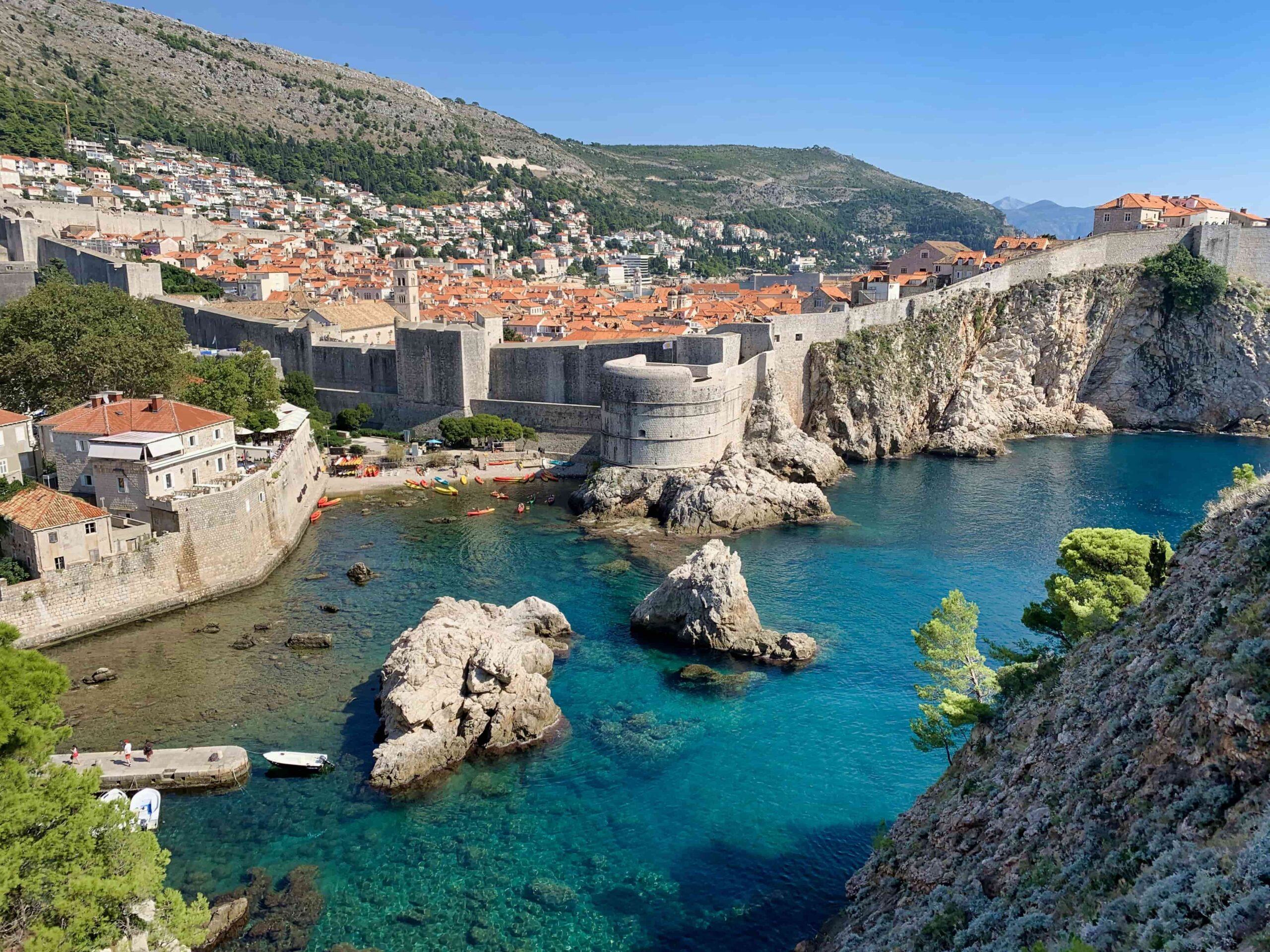

- Backpacker:
- Budget:
- Mid-range:
- Luxury:
Villa Dubrovnik
When it becomes dark, a foreign city may be twice as dangerous - especially if you don't understand the language and are unfamiliar with the area. There is no reason to be alarmed about walking home alone in the dark as there is not enough crime recorded in Dubrovnik to warrant any bit of worry. You can walk safely at night and never worry about crowded areas or unlit alleys or streets, but you can always take a taxi, if you don't feel comfortable.
The three-hour boat voyage from Dubrovnik to Hvar is offered by two distinct companies. Kapetan Luka is open from April to October, while Jadrolinija is open from June to September.
Day 2
Explore more
Dubrovnik’s Old Town most certainly left a lasting effect on you from last evening. Return for an early morning cable car journey to the summit of Mt. Srd for an unrivaled view point. Before heading (or trekking) back down to the level surface, stop at Panorama Restaurant for a well-deserved bite or drink.
Later, change into swimsuit and meet your captain for a private tour of the Elaphiti Islands in the afternoon. These 13 islands, off Dubrovnik, are completely unspoilt (with less than 1,000 total population). Eat, drink, laugh, and live large onboard your boat as you cruise from beach to beach, celebrating the fun in the sun all around this little island chain.
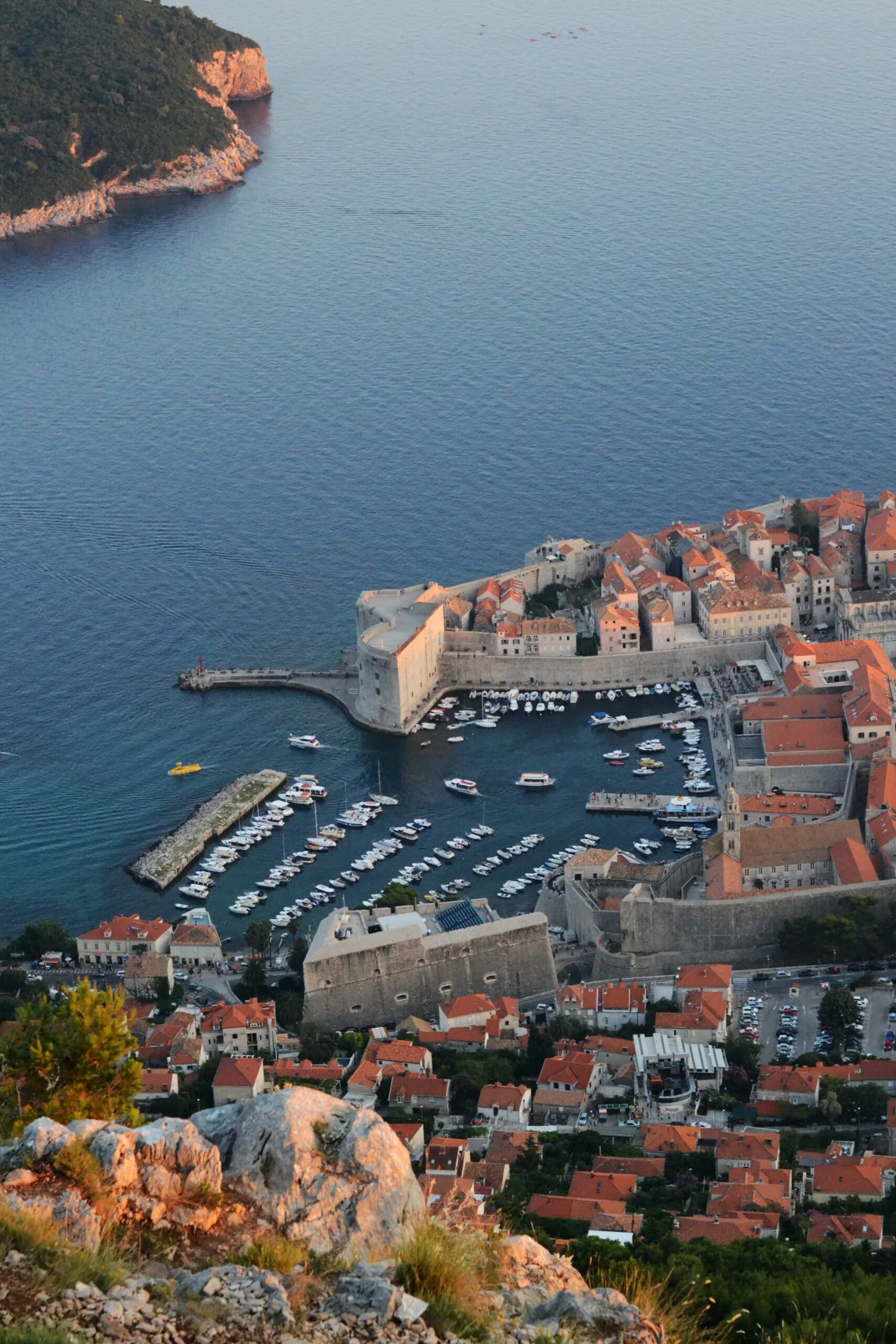


Day 3
Off to Hvar
Hvar island is Croatia’s crown gem, and visitors from all over the world rush to the country’s sunniest area. What more could you want for than dense environment, picture-perfect beaches, a lively main town, local wines, fresh cuisine, and general sumptuous island living?
Check into your accommodation, have a swim and a shower before traveling into Hvar Town to experience some of the greatest nightlife in the Mediterranean.
- Backpacker:
- Budget:
- Mid-range:
- Luxury:
The Adriana Hvar Spa Hotel
When it becomes dark, a foreign city may be twice as dangerous - especially if you don't understand the language and are unfamiliar with the area. There is no reason to be alarmed about walking home alone in the dark as there is not enough crime recorded in Hvar to warrant any bit of worry. You can walk safely at night and never worry about crowded areas or unlit alleys or streets, but you can always take a taxi, if you don't feel comfortable.
From Dubrovnik to Hvar
The boat ride from Dubrovnik to Hvar takes three hours and is operated by two different firms. Kapetan Luka operates from April to October, whereas Jadrolinija operates from June to September.
From Hvar to Split
The boat ride from Hvar to Split takes around an hour and a half, with many departures daily through Kapetan Luka.
Day 4
Side Exploration!
The splendor of Hvar Town is unearthly and should be experienced, but use this day to explore the rest of the island. Rent e-bikes and ride through the endless lavender fields of Brusje before heading into historically significant Starigrad for a beach meal.
Rent a car or scooter and head to Jelsa. Switch directions and continue south, passing through pine forests and lush olive orchards to reach Zavala and enjoy its stretch of gorgeous isolated beaches before returning before sunset.
When you return, go out for dinner and then start getting prepared for your journey tomorrow.



Day 5
Day Trip to Pakleni Islands
You’ve probably spotted the seemingly unspoilt tiny islets that dot the coast of Hvar. The Pakleni Islands are as follows: They are great for hopping from one to the next, with a total length of about 6 miles. Some cater to the yacht-party club crowd (such as Marinkovac), while others choose a more tranquil setting (like Jerolim).
Take a water taxi from Hvar Town to the largest island (Sveti Klement, often known as huge island), the nearest (Galesnik), or organize a trip to view all of them (like the famous Blue Cave). Dalmatino, a self-proclaimed steak and fish house that doubles down on good times by adding brandy samples throughout your meal, is the place to go for an evening supper and fitting farewell to Hvar.
Day 6
Off to Split
Don’t be fooled by the name – Split is very much tailored for couples travel, as an afternoon stroll along its palm-tree-lined riverbank promenade. After settling into your hotel, visit the Gallery of Fine Arts, which houses 700 years of Croatian art in a massive 18th-century edifice, or opt for a stroll around the palace or even hike up for the great views.
Enter the network of old passageways that make up Diocletian’s Palace, one of the most important remaining Roman ruins, first completed in 305 A.D. Shop to your heart’s content or simply appreciate the clash of old and modern – it’s unusual to witness everyday activities taking place in a previous ancient emperor’s palace. Dine in any of the great restaurants out there. After that, go over to Lvxor Kavana Cafe for a nightcap while listening to live music in the town square.


- Backpacker:
- Budget:
- Mid-range:
- Luxury:
Heritage Hotel Antique Split
When it becomes dark, a foreign city may be twice as dangerous - especially if you don't understand the language and are unfamiliar with the area. There is no reason to be alarmed about walking home alone in the dark as there is not enough crime recorded in Hvar to warrant any bit of worry. You can walk safely at night and never worry about crowded areas or unlit alleys or streets, but you can always take a taxi, if you don't feel comfortable.
From Hvar to Split
The boat ride from Hvar to Split takes around an hour and a half, with many departures daily through Kapetan Luka.
From Split to Plitvice National Park
The bus system in Croatia can get you to Plitvice National Park swiftly, but it will take a little longer than a guided trip.


Day 7
Exploring Plitvice National Park
Nature lovers, take note: if time permits, you should definitely visit Krka National Park or continue on from Split to Plitvice National Park to witness rushing waterfalls, enormous rivers, and amazing vistas over the hilly terrain of central Croatia.
Plitvice Lakes National Park is a UNESCO World Heritage Site and one of Croatia’s most famous tourist destinations. Its 16 lakes are linked by a succession of waterfalls, all of which may be reached on foot by walking trails and wooden bridges, providing an unforgettable outdoor experience.

While the lakes are beautiful, they may serve as a reason to return to Croatia if you don’t get to them this time. If you don’t feel like going on another adventure, remaining in and around Split is a good option.
Head to Bacvice Beach or its adjoining Ovcice Beach for an urban swim with locals and visitors alike – both bustling with cafés, restaurants, and inviting water asking to be swum in. Look out into the distance at the scattered islands, some of which you’ve conquered, and let the Croatian sun kiss you farewell as the day comes to an end.
Take your final Dalmation comfort cuisine at its finest at Uje Oil Bar. You can buy their olive oil as well.
Day 8
Departure
This 8-day trip to Croatia opened up the country’s many cultural and architectural marvels, extraordinary nature and wildlife, as well as experiences that you wouldn’t have elsewhere. It is now time for your departure, and sadly your last goodbyes to Croatia. Pack your belongings and get ready to head to Split International Airport to catch your flight back home.
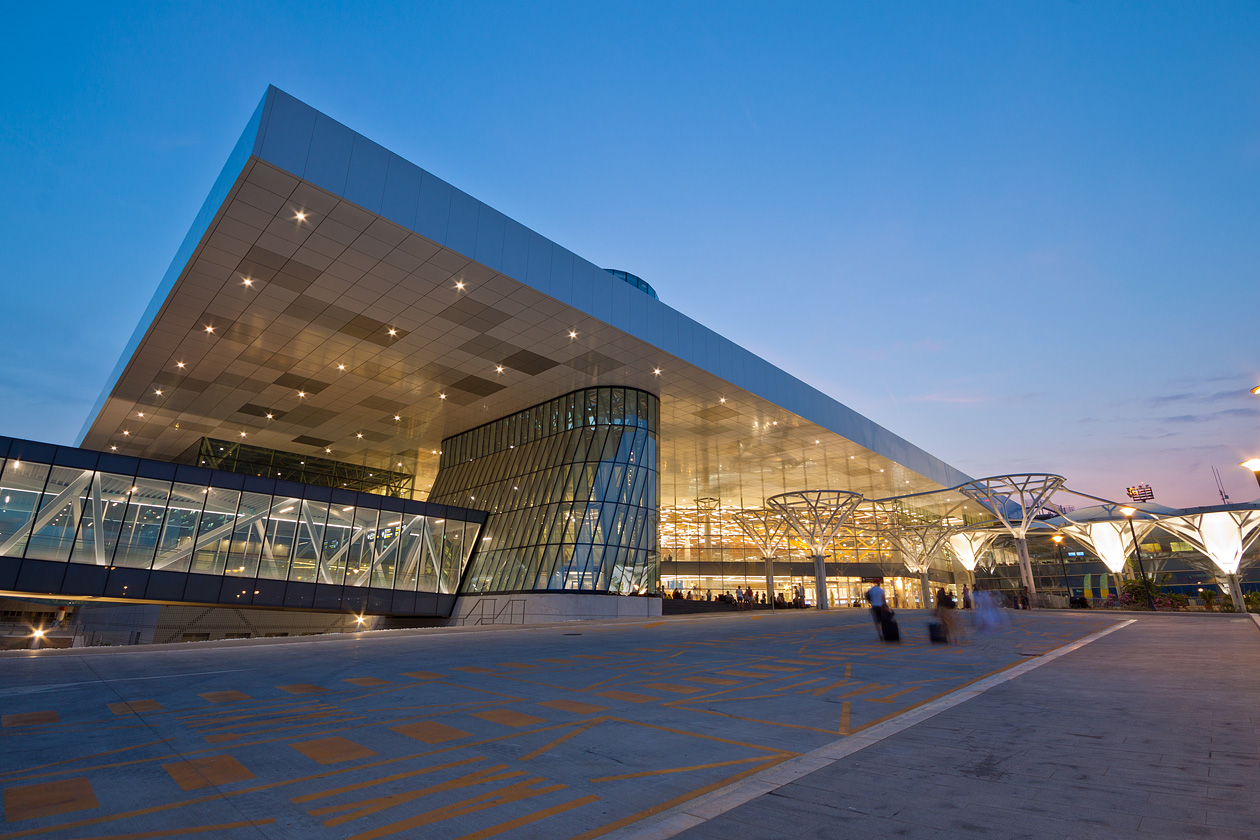
The Most Popular Food in Croatia
Traditional Croatian cuisine shares certain similarities with those of Italy, Austria, Hungary, and Turkey. Croatian meals, on the other hand, have their own particular interpretation and flavor. Croatian cuisine is more akin to Greek and Mediterranean cookery. Although Dalmatian and Istrian cuisines are influenced by Italian and Mediterranean cooking, pasta, gnocchi, and pizza are popular across Croatia. Pasta is also a prominent culinary item in Croatian cuisine, particularly in the Dalmatian area, considered a staple. Creamy mushroom sauce, minced beef sauce, and a variety of other sauces are also widespread. While pizza originated from Naples, you will have your doubts when eating pizza in Croatia as they make the best you will ever eat.
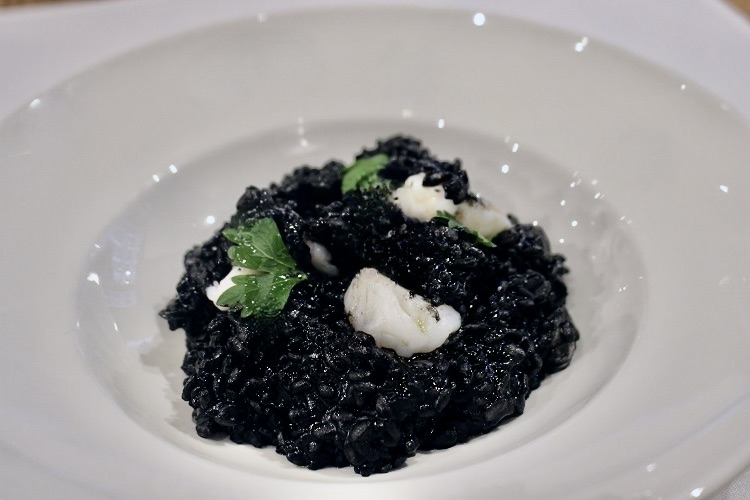
Crni rizot (Black Risotto)
Crni rizot is essentially a squid risotto that is colored black with squid ink and almost all the restaurants in Croatia offer this dish on its menu. Aside from squids, this risotto frequently includes mussels, clams, and other shellfish. Squid ink gives the characteristic color and flavor, while squid and other fish offer the meaty elements. The meal is considerably more delicious than it sounds or looks, but be warned that it will leave your teeth and tongue black – not ideal for a first date.
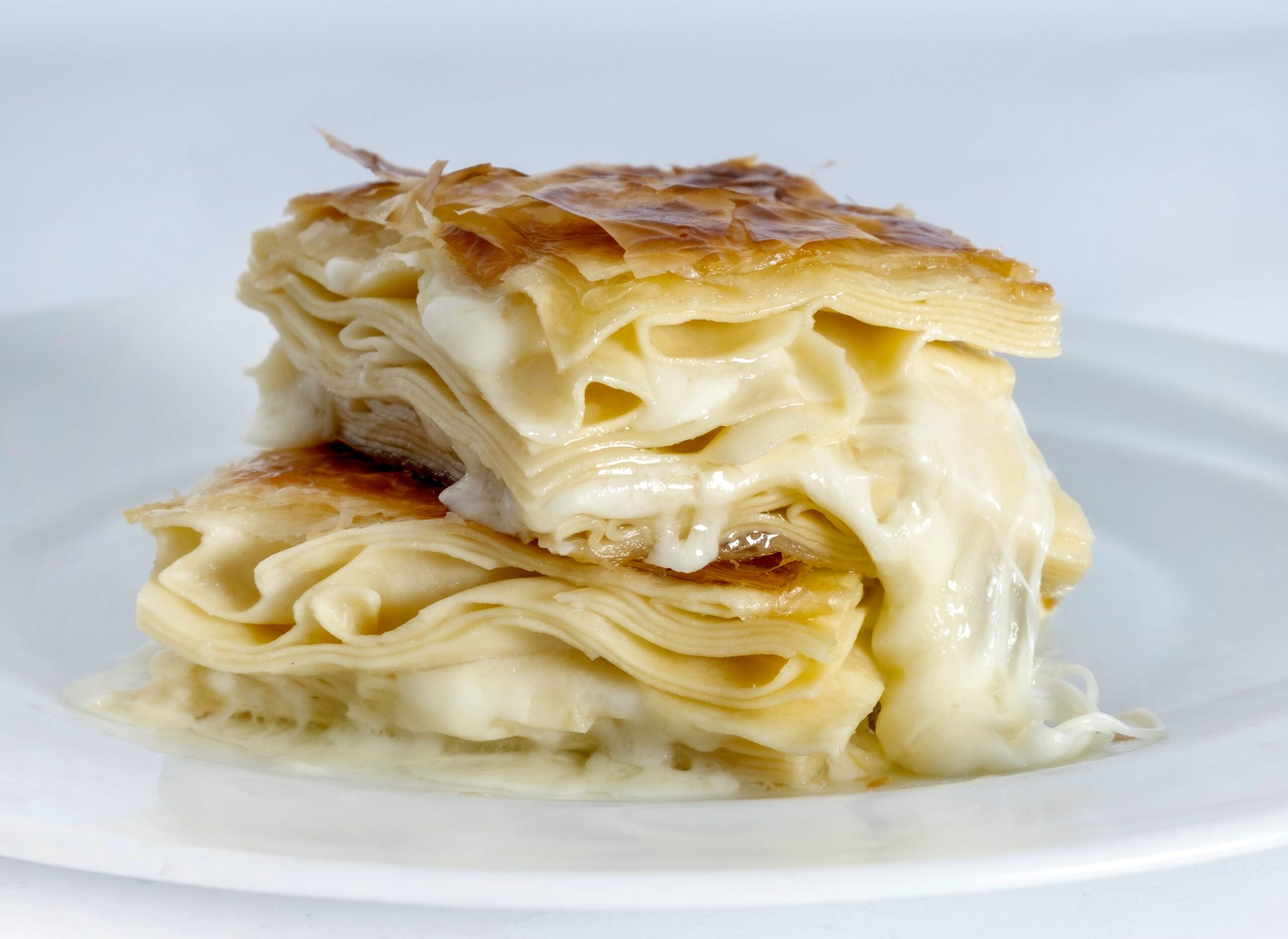
Strukli
Originally invented by Slovenians, Strukli is a relative of strudel, filled pillows of dough eaten as dessert or as a mid-morning or mid-afternoon delicacy and is a popular food in Croatia, found in and around Zagreb and Zagorje. These little yet filling servings, baked or boiled, are typically stuffed with cottage cheese and smeared with cream.
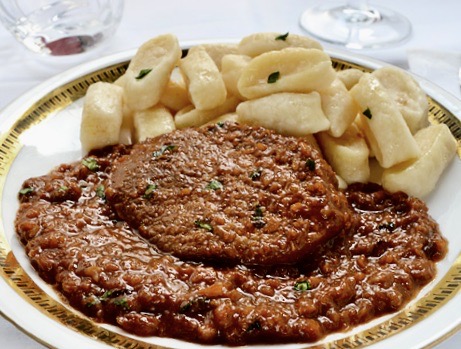
Pasticada With Gnocchi
Pasticada, often known as the Queen of Dalmatian cuisine, is a popular Dalmatian dish with culinary roots to southern France. It’s a stew made with marinated beef, prunes, figs, and wine or prosecco. Preparing a paticada takes around 24 hours, including an overnight soak in vinegar, garlic, and wine. On special saints’ days or at weddings, it is served with homemade gnocchi.

Burek
Pita or burek is an essential element of not only Croatian but also Balkan cuisine, with Bosnia producing some of the greatest. Many bakeries, on the other hand, spend the time and effort to properly prepare it, filling these flaky, piled pastries with cheese, apple, or meat while remaining oily. If breakfast isn’t included in the price of your hotel or hostel stay, this is the perfect economical filler to carry you through from mid-morning to early evening, and it’s also a great snack to take with you on hikes or other adventures.
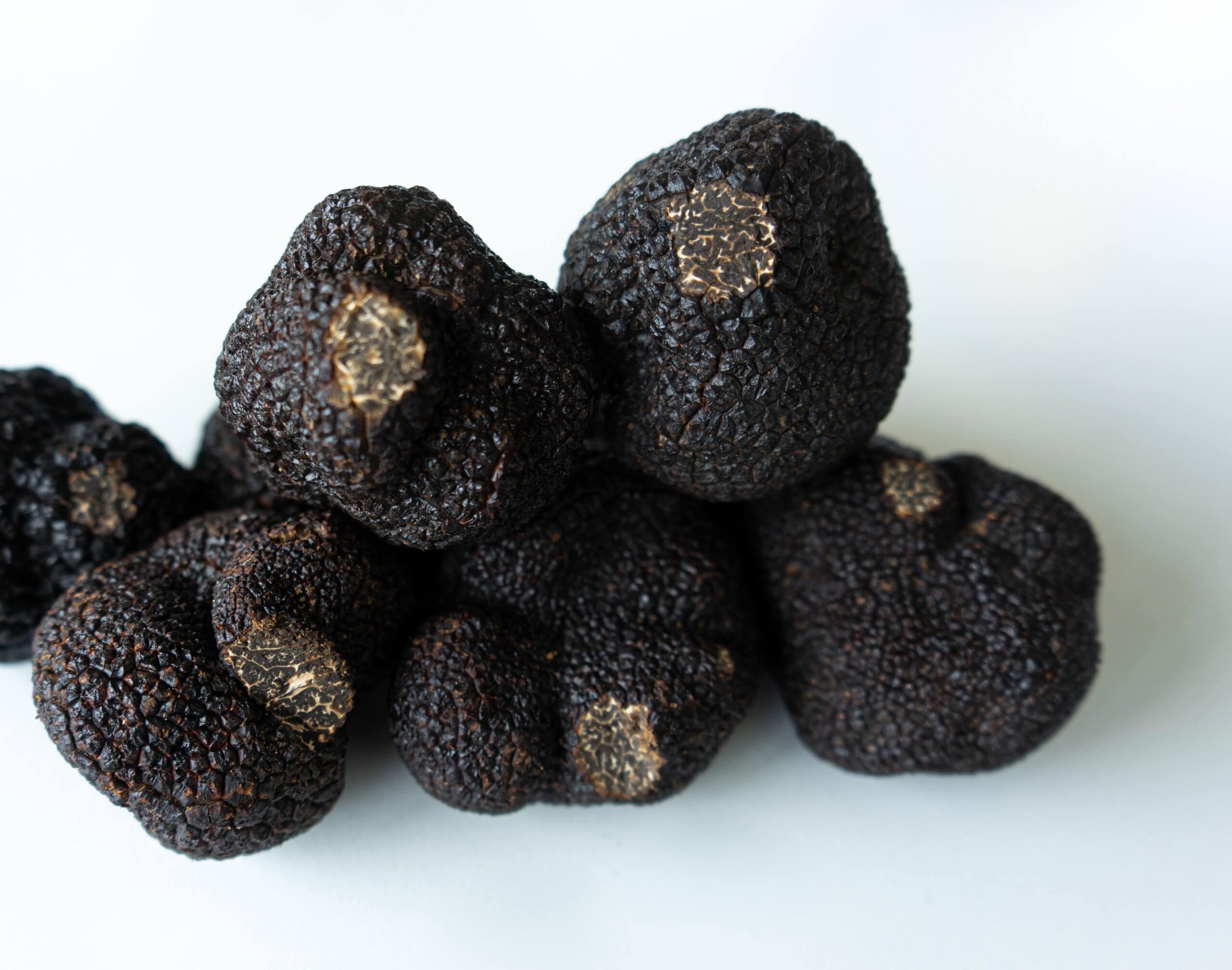
Istrian Truffles
Truffles are more than a cottage industry in Istria; they’re a major business. Look for the Tartufo Vero symbol, which indicates that the restaurant has satisfied Istria’s stringent criteria for handling and serving the delicacy. Weekends in October in Livade feature truffle judging, cooking lessons, and truffle auctions. Zigante, Istria’s most famous truffle restaurant, is a must-try.
What's the Travel Budget for Croatia?
Flights
- Flights start at roughly $280 from nearby countries. Tickets however on average cost around $550 and can cost way more depending on which class and from which country you depart from.
Accommodation
- Nomad Backpacking style travelers can expect to spend around $150 for a week
- Budget travelers can expect to spend around $350 for a week
- Mid-range travelers can expect to spend around $700 for a week
- Luxury travelers can expect to spend around $1,100 for a week
Food Budget (Three meals and drinks)
- Nomad Backpacking style travelers can expect to spend around $15 per person per day
- Budget travelers can expect to pay around $25 per person per day
- Mid-range travelers on average would cost $30 to $45 per person per day
- Luxury travelers can expect to pay around $60 to $120 per person per day
Overall Budget Styles (Not including Flights, Tours, Transportation, or Car Rental)
- Nomad Backpacking style travelers can expect to spend roughly $250 for a week
- Budget travelers can expect to spend close to $420 for one person for a week
- Mid-range travelers can expect to spend approximately $710 for one person for a week
- Luxury travelers can expect to spend around $1,750 for one person for a week
Flights
- Flights start at roughly $280 from nearby countries. Tickets however on average cost around $550 and can cost way more depending on which class and from which country you depart from.
Accommodation
- Nomad Backpacking style travelers can expect to spend around $150 for a week
- Budget travelers can expect to spend around $350 for a week
- Mid-range travelers can expect to spend around $700 for a week
- Luxury travelers can expect to spend around $1,100 for a week
Food Budget (Three meals and drinks)
- Nomad Backpacking style travelers can expect to spend around $15 per person per day
- Budget travelers can expect to pay around $25 per person per day
- Mid-range travelers on average would cost $30 to $45 per person per day
- Luxury travelers can expect to pay around $60 to $120 per person per day
Overall Budget Styles (Not including Flights, Tours, Transportation, or Car Rental)
- Nomad Backpacking style travelers can expect to spend roughly $250 for a week
- Budget travelers can expect to spend close to $420 for one person for a week
- Mid-range travelers can expect to spend approximately $710 for one person for a week
- Luxury travelers can expect to spend around $1,750 for one person for a week
Flights
- Flights start at roughly $280 from nearby countries. Tickets however on average cost around $550 and can cost way more depending on which class and from which country you depart from.
Accommodation
- Nomad Backpacking style travelers can expect to spend around $150 for a week
- Budget travelers can expect to spend around $350 for a week
- Mid-range travelers can expect to spend around $700 for a week
- Luxury travelers can expect to spend around $1,100 for a week
Food Budget (Three meals and drinks)
- Nomad Backpacking style travelers can expect to spend around $15 per person per day
- Budget travelers can expect to pay around $25 per person per day
- Mid-range travelers on average would cost $30 to $45 per person per day
- Luxury travelers can expect to pay around $60 to $120 per person per day
Overall Budget Styles (Not including Flights, Tours, Transportation, or Car Rental)
- Nomad Backpacking style travelers can expect to spend roughly $250 for a week
- Budget travelers can expect to spend close to $420 for one person for a week
- Mid-range travelers can expect to spend approximately $710 for one person for a week
- Luxury travelers can expect to spend around $1,750 for one person for a week
Flights
- Flights start at roughly $280 from nearby countries. Tickets however on average cost around $550 and can cost way more depending on which class and from which country you depart from.
Accommodation
- Nomad Backpacking style travelers can expect to spend around $150 for a week
- Budget travelers can expect to spend around $350 for a week
- Mid-range travelers can expect to spend around $700 for a week
- Luxury travelers can expect to spend around $1,100 for a week
Food Budget (Three meals and drinks)
- Nomad Backpacking style travelers can expect to spend around $15 per person per day
- Budget travelers can expect to pay around $25 per person per day
- Mid-range travelers on average would cost $30 to $45 per person per day
- Luxury travelers can expect to pay around $60 to $120 per person per day
Overall Budget Styles (Not including Flights, Tours, Transportation, or Car Rental)
- Nomad Backpacking style travelers can expect to spend roughly $250 for a week
- Budget travelers can expect to spend close to $420 for one person for a week
- Mid-range travelers can expect to spend approximately $710 for one person for a week
- Luxury travelers can expect to spend around $1,750 for one person for a week
If you want to know what to pack, read this list below:
- This is a casual European country with Mediterannean weather that tends to be warm or hot in the summer, and cold in the winter, dress accordingly
- Raincoat or Light Waterproof Jacket
- Hiking Boots or Sturdy Sneakers (Shoes You Don’t Mind Getting Wet)
- Sunscreen
- Insect Protection – Repellent and Clothing
- Sunglasses and Sun Hat
- Water Shoes
- Beach Towels/Sarong
- Dry Bag
- Money Belt or Cross Bag
- Portable Medical Kit
- Flashlight or Headlamp
- Copies of your passport.
- Get all the needed vaccinations before traveling
- A power bank is a must in any travel.
- Always have some cash with you just in case there are no ATMs and if you are dealing with a business that solely accepts cash
- Get yourself an adapter for your gadgets
- 1 toothbrush
- 1 tube of toothpaste
- 1 razor
- 1 package of dental floss
- 1 small bottle of shampoo
- 1 small bottle of shower gel
- 1 towel
- Deodorant
- Band-Aids
- Hydrocortisone cream
- Antibacterial cream
- Earplugs
- Tylenol
- Hand sanitizer (germs = sick = bad holiday)
- A key or combination lock
- Zip-lock bags
- Plastic bags (great for laundry)
- Universal charger/adaptor
- LifeStraw (A water bottle with a purifier)
- 1 dry shampoo spray & talc powder
- 1 hairbrush
- Makeup you use
- Hairbands & hair clips
- Feminine hygiene products
Clothing For Boys
- 1 pair of jeans or khaki pants
- 1 pair of shorts
- 1 bathing suit
- 5 T-shirts
- 1 long-sleeved T-shirt
- 1 pair of flip-flops
- 1 pair of sneakers
- 6 pairs of socks
- 5 pairs of boxer shorts
Clothing For Girls
- 1 swimsuit
- 1 sarong
- 1 pair of stretchy jeans
- 1 pair of leggings
- 2-3 long-sleeve tops
- 2-3 T-shirts
- 3-4 spaghetti tops
- 1 light cardigan
Want to plan your own trip, here are some of the best resources that can help you
- Skyscanner – They search small websites and budget airlines that larger search sites tend to miss. They are hands down the number one place to start.
- Momondo – This is another favorite flight search engine because they search such a wide variety of sites and airlines. Always check here too.
- Booking.com – The best all-around booking site that constantly provides the most affordable and lowest rates. They have the widest selection of budget accommodation.
- Couchsurfing – This website allows you to stay on people’s couches or spare rooms for free. It’s a great way to save money while meeting locals who can tell you the ins and outs of their city. The site also lists events you can attend to meet people (even if you’re not staying with someone).
- Intrepid Travel – If you want to do group tours, go with Intrepid. They offer good small group tours that use local operators and leave a small environmental footprint.
- Grassroots Volunteering – For volunteering, Grassroots Volunteering compiles a list of good local volunteer organizations that keep the money within the community.
- Get Your Guide – Get Your Guide is a huge online marketplace for tours and excursions. They have tons of tour options available in cities all around the world, including everything from cooking classes, walking tours, street art lessons, and more! It has the world’s largest collection of things to do with more than 30,000 activities in 7500 destinations.
- SafetyWing – Safety Wing offers convenient and affordable plans tailored to digital nomads and long-term travelers. They have cheap monthly plans, great customer service, and an easy-to-use claims process that makes it perfect for those on the road.
- Trip Advisor: Check the reviews and then book your accommodation. TripAdvisor is where you go when you want to compare prices with multiple accommodation providers.
- VRBO: is the main search engine to use when you are looking for a home or apartment rental. It can sometimes be cheaper than hotels and it is the best way to stay in areas that offer a more local feel.
- Hostelworld: With one of the largest databases of hostels in the world, Hostelworld is the go-to site when you are looking for budget accommodation.
- Rome 2 Rio: If you want to see how to get somewhere by plane, train, bus, ferry, or car Rome2Rio lays it all out for you as well as related costs.
- World Nomads Insurance: When traveling you should always have travel insurance. We have found the best bang for your buck is by far World Nomads.
Final Thoughts on Croatia
With its diverse structures and heritage, traditional buildings, stunning and unique landmarks, incredible hospitality, exciting songs and dances, and breathtaking picture-perfect backdrop of forests, pristine beaches, and city walls, Croatia has a refined and rich heritage that can be seen across the nation dating back to at least the 7th century AD. A fantastic option for anyone seeking for one of the best destinations to visit in Europe. Croatia is breathtakingly beautiful, with wonderful national treasures, fauna, and majestic scenery. Would you visit Croatia?
Have you ever been to Croatia? Please share your thoughts and experiences in the space below.